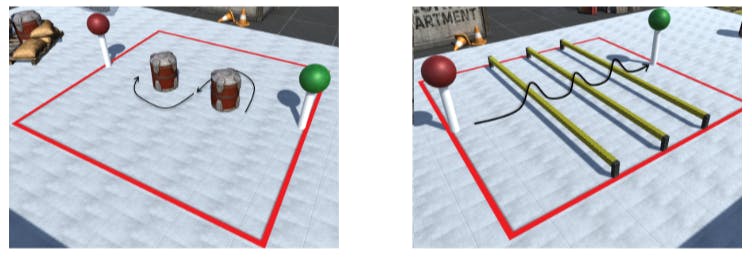Authors:
(1) Rafael Kuffner dos Anjos;
(2) Joao Madeiras Pereira.
Table of Links
Abstract and 1 Introduction
2 Related Work and 2.1 Virtual avatars
2.2 Point cloud visualization
3 Test Design and 3.1 Setup
3.2 User Representations
3.3 Methodology
3.4 Virtual Environment and 3.5 Tasks Description
3.6 Questionnaires and 3.7 Participants
4 Results and Discussion, and 4.1 User preferences
4.2 Task performance
4.3 Discussion
5 Conclusions and References
3.3 Methodology
The test was divided into eight stages: 1) introduction to the study and application of pre-test questionnaire; 2) explanation about the tasks and each of the users representations 3) adjustment of the device for comfort; 4) calibration procedure; 6) task execution; 7) application of post-test questionnaire; 8) and a semi-structured interview.
At first, we explained the test objectives. Then, the users completed a pre-use questionnaire to raise the participants profile regarding previous experience with related technologies (HMDs, virtual avatars, etc).
Subsequently, we showed a brief description of the tasks and representations used. Furthermore, we presented the users with the calibration task. This procedure was performed to calibrate the tracking system between the HMDs and the depth-sensors. Then, in order to familiarize the user with the procedures, users performed a task in a training scenario, where they could freely explore the virtual environment and familiarize themselves with the setup and each of the representations.
After performing the training task, the users reached a fixed object on the environment and the users performed the test task. Then a questionnaire was given to the users for some user experience issues. These steps were done for each of the combination of the test conditions(perspective and representation) of a total of 12 permutations. The order of the avatar representation was changed in every test, following a Latin square arrangement, to avoid biased results.
3.4 Virtual Environment
The selected environment is based on the Stealth Scene, which was obtained on the Unity Asset Store[1]. This scene was modified to remove visual clutter, for not interfering with the goals of the test, stealing user’s attention.
We also included in the environment a representation of the Kinect’s tracking limits with a red square, where the user could walk freely.
3.5 Tasks Description
Because of the reduced size of the tracked space (4 meters by 4 meters), we decided to divide the test in four tasks. For each of the tasks, the user need to reach a specific point at the end of the tracked space, where he needs to reach a colored sphere (either red or green) with their hand to pass to the next Task. The Tasks were chosen based on natural Tasks such as walking,avoiding obstacles and catching moving objects based on previous work [28].
After that, he turns his body to face the next task, until the test ends. In the following subsections we present and explain in further detail each of the Tasks.
3.5.1 First Task
In this task, after reaching the green object the user turns his body and needs to go around the barrels, first by the right, then by the left until they reach the read target object. Figure 3a illustrates the first Task.
3.5.2 Second Task
In the second task, the user needs to avoid each of the yellow bars by raising their feet (or jumping) until they reach the green target Object (Figure 3b).
3.5.3 Third task
The user needs to avoid the yellow bar by going under it. This bar is adjusted according to the user’s height, which is estimated using the distance between the head and the toe when the user starts the test. The bar is placed 12 centimeters less than the total height of the user (Figure 3c).
3.5.4 Fourth task
In the final task the user needs to reach a small red square located in front of the red target object. This task is a Reflex-based task which consists in four balls been thrown towards the user by a cannon (Figure 3d). To succeed in this task they need to stop them using their body. All balls are thrown with the same speed, varying only the point they are thrown at. The first ball is thrown toward the user’s chest, second and third towards user’s right and left arm. The fourth ball is thrown at the user’s right side but he needs to walk to the right to reach it.
3.6 Questionnaires
To gather users profiles, preferences a pre-test questionnaire was conducted. For assessing human factors such as comfort, sense of embodiment and satisfaction, a post-test questionnaire was conducted. The post-test questionnaire was comprised of a list of 11 statements followed by a Likert Scale of 6 values, where 1 means that the user does not agree completely with statement and 6 means he fully agrees with it, as summarized in Table 1. The first four questions, based on previous work [7], were used to estimate user’s sense of embodiment and each of its sub-concepts : sense of embodiment (Q1), sense of body ownership (Q2) ,sense of self-location (Q3) and also body control (Q4). The following questions were made to assess the easiness of each of the subtasks and fatigue.
In addition to the questionnaire, we conducted a semi-structured interview in order to capture the participants’ perceptions about the accomplished tasks, clarify about their answers on the post-test questionnaire and get improvement suggestions.
3.7 Participants
For this test we chose 24 participants, 5 of which were female. The ages of the users varied from 21 to 35 years. Regarding experience, the majority of the users had previous experience with 3d applications such as games and modelling systems. The majority of them with experience with previous experience with Head-Mounted Displays.
[1] http://unity3d.com/store












